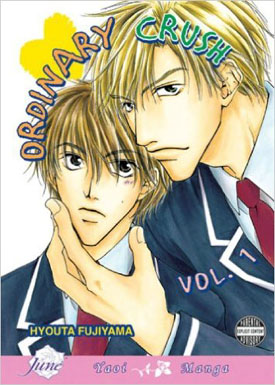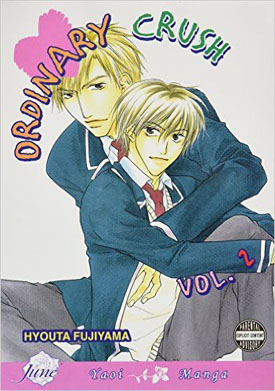Hyouta Fujiyama has become one of my favorite mangaka doing BL, mostly because of her strong, clean graphics and charming stories. (For some general remarks on BL, see my comments on Dash!.) In Ordinary Crush we have the core of a complex of stories portraying the students of Kinsei High, a highly regarded all-boys’ school that is rumored to be 90% gay.
 The main story, “Ordinary Crush,” is about two students — two of the few straight students, as it happens — at Kinsei. When the story begins, Koichi Nanase is a second-year student and a member of the volleyball club. He is small, lively — although “volatile” might be a better term — and very cute. Tsuguharu Taira, known to all as “Heiji,” is a first-year, tall, supremely laid back, and also a member of the volleyball club. Heiji approaches Nanase with a proposal: he, Heiji, is being stalked by a very persistent girl, and it’s making him nervous. He’s told her he’s dating his sempai, meaning Nanase, and proposes that Nanase go along with the story: they are not really interested in each other, Nanase is cute enough to make the story credible, and it will insulate both of them from unwanted suitors (Nanase, as it happens, is being pursued by Furuya, a Kinsei graduate who helps out at the volleyball club). It’s not long before Nanase realizes that he’s very comfortable with Heiji, no tension in their relationship at all, and wonders if they could get away together, just the two of them. As it happens, Heiji feels the same way. As it turns out, Heiji wasn’t pretending, and that’s just fine with Nanase. Then, of course, come the hurdles.
The main story, “Ordinary Crush,” is about two students — two of the few straight students, as it happens — at Kinsei. When the story begins, Koichi Nanase is a second-year student and a member of the volleyball club. He is small, lively — although “volatile” might be a better term — and very cute. Tsuguharu Taira, known to all as “Heiji,” is a first-year, tall, supremely laid back, and also a member of the volleyball club. Heiji approaches Nanase with a proposal: he, Heiji, is being stalked by a very persistent girl, and it’s making him nervous. He’s told her he’s dating his sempai, meaning Nanase, and proposes that Nanase go along with the story: they are not really interested in each other, Nanase is cute enough to make the story credible, and it will insulate both of them from unwanted suitors (Nanase, as it happens, is being pursued by Furuya, a Kinsei graduate who helps out at the volleyball club). It’s not long before Nanase realizes that he’s very comfortable with Heiji, no tension in their relationship at all, and wonders if they could get away together, just the two of them. As it happens, Heiji feels the same way. As it turns out, Heiji wasn’t pretending, and that’s just fine with Nanase. Then, of course, come the hurdles.
 The first is a new first-year — we have now started a new term — Yamato Mizusawa, who has loved Heiji since middle school. He finds himself in league with Okouchi, another graduate, who has the reputation of not being able to keep his hands off things that aren’t his — in this case, Nanase. They set Heiji up to be caught in a compromising situation with Mizusawa, but things don’t quite work out the way Okouchi planned. The second hurdle, in volume 2, is Koichi’s older brother, Youichi, who takes his responsibilities as big brother very seriously and doesn’t like his brother dating another guy at all. And then, of course, there’s sex, another hurdle for first-time lovers, especially if, like Nanase, they tend to think too much.
The first is a new first-year — we have now started a new term — Yamato Mizusawa, who has loved Heiji since middle school. He finds himself in league with Okouchi, another graduate, who has the reputation of not being able to keep his hands off things that aren’t his — in this case, Nanase. They set Heiji up to be caught in a compromising situation with Mizusawa, but things don’t quite work out the way Okouchi planned. The second hurdle, in volume 2, is Koichi’s older brother, Youichi, who takes his responsibilities as big brother very seriously and doesn’t like his brother dating another guy at all. And then, of course, there’s sex, another hurdle for first-time lovers, especially if, like Nanase, they tend to think too much.
There are, as usual, side stories, most of which involve characters who appear in “Ordinary Crush.” Volume 1 contains two that do not, the first a cryptic little story about two roommates who had a sexual encounter that has some unlooked for fallout. The second, “Automatic Smile,” has a science-fiction element: Narita, a somewhat misanthropic writer, has an android, Akira, a gift of his somewhat bothersome mother. Akira is teaching himself to be more human, a project that Narita views with some annoyance — humans are noisy and unpredictable. This one continues in volume 2 with “Automatic Smile: Not-For-Ever.” It’s times for Akira’s routine maintenance, and Narita finds himself facing the question of whether he would want Narita back at the end of his cycle. It’s a story that touches on some questions about liking, love, and engagement in a very elliptical but interesting way.
Another side story that becomes its own series centers on Mizusawa, small, very cute — one of the top five cute boys in the new class — and somewhat precipitous in arriving at conclusions. He manages to get involved with the school doctor, Kazuhiro Asano, who generally doesn’t have time for students aside from patching them up when necessary.
My favorite side story — perhaps my favorite of all — is the series about the romance between Furuya and Aikawa, another graduate of Kinsei, which begins with “Love Is There For The Taking” in volume 1. Furuya’s “type” has always been small and lively, like Koichi Nanase. Furuya is tall — 195 cm — but Aikawa is even taller. He’s also quiet, somewhat shy, and, as Furuya begins to realize after their first confrontation, absolutely adorable. Their courtship is not without obstacles — one of the most delightful being Ryuhei Ohno, younger brother to Heiji’s “stalker” in “Ordinary Crush” and the central character in a spin-off, Sunflower. In the second Furuya-Aikawa story, “Love Changes,” Ryuhei proves himself to be full of mischief — although much younger, Ryuhei is also in love with Aikawa, who is his occasional substitute tutor, and finds ways to be a pain in the neck during a chance meeting he and Aikawa have with Furuya. There are two more stories in this series that appear in Sunflower, volume 1, the first of which is also the beginning of Ryuhei’s story.
Another spin-off, Freefall Romance, features Koichi’s brother, Youichi, who has his own romantic entanglement with a work partner. Given his reaction to Koichi’s affair with Heiji, the irony in this story is almost palpable.
I think I like the Furuya-Aikawa series especially because it is almost completely a character-driven story (and the fact that Aikawa is one of the most appealing characters in BL manga). Character, in fact, is one of Fujiyama’s strengths. The driving force for the humor in “Ordinary Crush” — and it is really a very funny series — it Koichi Nanase’s personality playing off Heiji’s, as well as his brother’s. Nanase is an airhead, more than a little obsessive, who definitely marches to his own drummer, while Heiji is somewhat manipulative, quite calm and rational, and tends to justify things with the comment “It worked out well, didn’t it?” Youichi is fairly rigid, anal, and totally unprepared for his brother, who specializes in bolts from the blue. There are other characters who add more dimensions to these stories — Saijo, Doctor Asano’s cousin, who seems to be plugged in to all the school gossip and serves as everyone’s shoulder to cry on, probably because he refuses to get involved with anyone himself, and who has some penetrating — and withering — observations to make on the Nanase-Heiji liaison; Okouchi, who is a real snake; and Furuya, who, as it turns out, is a really good guy.
Other pluses: I mentioned Fujiyama’s clean, strong graphic style, exceptionally legible, which contributes to a clear narrative flow. I find myself lingering over particular frames simply because they are so appealing. There’s also a strong measure of psychological realism here, within a highly romantic framework, all of which makes this group a particularly engaging example of BL manga. Sex, when they finally get around to it, is pretty demure. Fujiyama’s one drawback is that she seems to rely on two main templates — large and handsome, or small and cute — and a limited number of variations in character renderings, although somehow this doesn’t seem to translate into any real difficulty in telling which character is which.
On the whole, it’s a series I can recommend, but be warned — you’ll most likely find yourself hunting down all the spin-offs as well.
(Juné (Digital Manga, Inc.), 2007 [orig. Frontier Works, Inc. (Japan), 2001])
